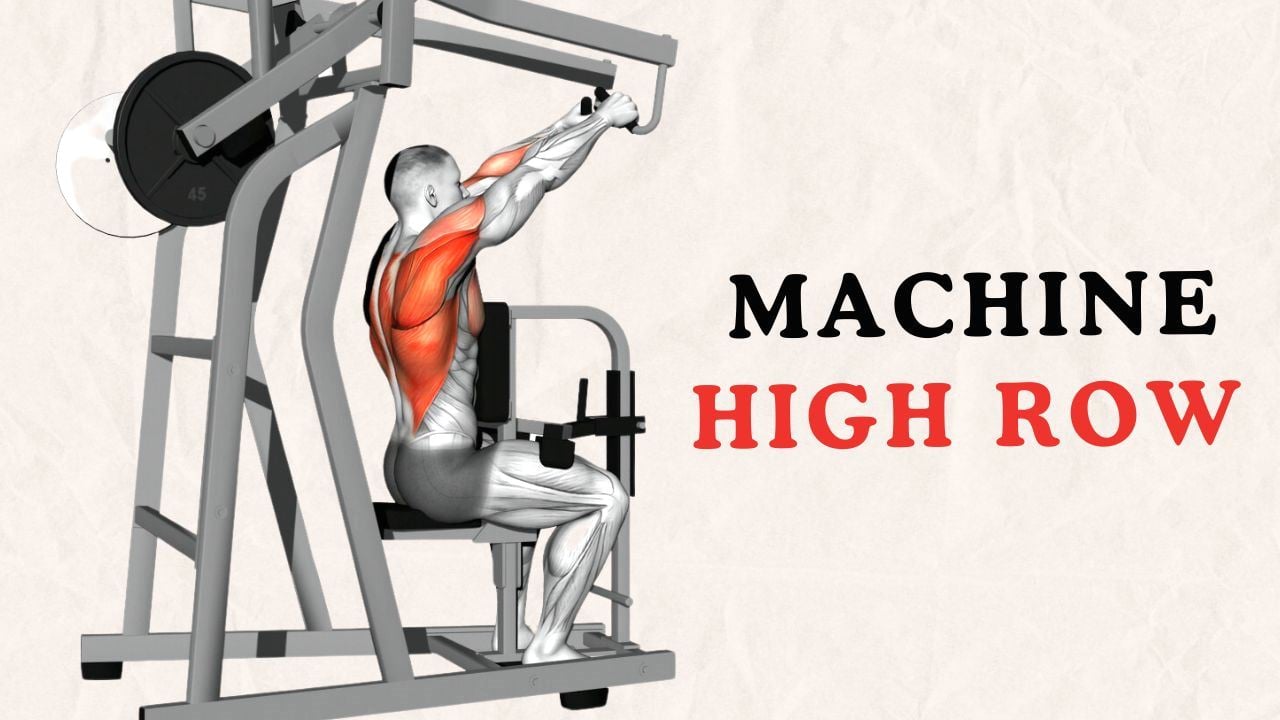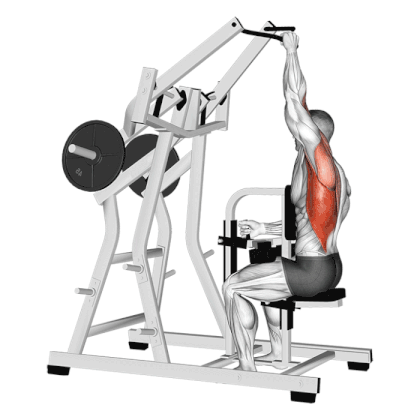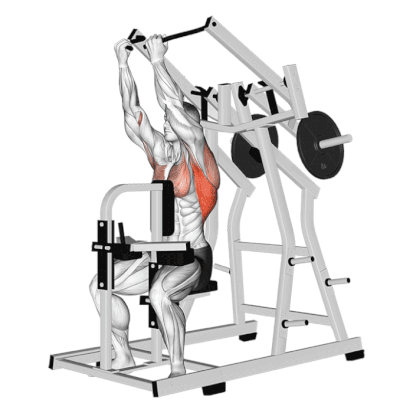The machine high row, often referred to as the Hammer Strength High Row, is a compound pulling exercise designed to target the upper back, biceps, and other associated muscles.
It is a great exercise for the lats. As you switch from a pronated to a supinated grip and do deeper movements, the lower lats (a commonly deficient area) become the main target.
It is a combination of vertical and horizontal pulling exercises that can be used with other exercises, such as lat pulldowns and barbell rows.
Unlike traditional rows, where you pull horizontally or lat pulldowns, where you pull down vertically, the machine high row allows you to pull down at an angle that cannot be replicated with dumbbells or barbells.
This makes the machine high row a unique and irreplaceable tool in your strength training arsenal.
The high-row machine has several standout features, including isolating lat muscles and accommodating heavy loads. This is especially good for people who want to build strength and muscle mass. The machine’s stability lets you lift heavier weights without sacrificing form.
There are many ways to do high machine row:
- Bilateral Training: Both arms simultaneously. It allows for heavier weights.
- Unilateral Training: Focuses on one arm at a time. It helps to correct muscle imbalances.
- Overhand grip (palms down): This grip targets the upper back, including traps and rhomboids. It is ideal for building a thicker, more defined upper back.
- Underhand Grip (palms-up): Shifts focus to the lower lats and biceps.
- Neutral Grip: This grip provides balanced activation of both upper and lower lats, with a natural wrist position that’s easier on the joints.

Muscles Worked During Machine High Row
The high row machine is an excellent exercise for strengthening the muscles in your back.
- Primary Muscle: Latissimus Dorsi
- Secondary Muscles: Teres Major, Rhomboids, Trapezius (middle and lower fibers) and Posterior Deltoid
- Stabilizing Muscles: Biceps Brachii, Brachialis, Brachioradialis, Rotator Cuff Muscles (Supraspinatus, Infraspinatus, Teres Minor, Subscapularis), forearms, Erector Spinae, Obliques and Rectus Abdominis
How To Do Machine High Row
- Set the seat so that your feet are flat on the floor and your thighs are parallel to the ground.
- Set the thigh pad to rest firmly on top of your legs. If you need to choose, set it slightly lower rather than higher.
- Ensure the chest pad is firm against your chest, providing support as you pull.
- Stand up and grab the handles with your desired grip (overhand, underhand, or neutral).
- Sit down, place your legs under the thigh pads, and press your chest firmly against the chest pad.
- Retract your scapula (pull your shoulder blades back) before you start the movement. This creates a strong base and prevents your shoulders from rounding forward.
- Pull the handles toward your chest and drive your elbows down and back. Focus on moving your elbows, not just pulling the handles. This ensures your back muscles do the work instead of your biceps.
- Pull the handles until they reach your chest level, then give your back muscles a slight squeeze.
- Slowly and controlled, extend your arms to return to the starting position.
Tips and Form
- Before you start a row, pull your shoulder blades together and down. This not only engages the back muscles better, but also protects your shoulders from excessive strain.
- Keep your spine neutral and avoid rounding your lower back. Your chest should be up and pressed firmly against the pad throughout the movement.
- Drive your elbows down and back at roughly a 45-degree angle to your torso. Avoid pulling the elbows too close to your sides (which overemphasizes the lats) or too far out (which can strain the shoulders).
- If you can, keep your hips and knee joints at a 90-degree angle. This position allows you to use your lower body more effectively for force production.
- If your grip gives out before your back and biceps, don’t hesitate to use weight straps on the last few sets.
- Don’t rush through the movement. Pull the handles smoothly and with control, then lower them back slowly.
- Experiment with different grips (overhand, underhand, neutral) to target lats from different angles. Each grip slightly impacts the biomechanics of the movement and muscles worked.
Machine High Row Variations
1. Single Arm Machine High Row
The single-arm machine high row offers distinct advantages over traditional machine high rows. It allows for greater muscle activation on each side, which enables you to target and strengthen any imbalances between your left and right sides.
Single arm row promotes a better mind-muscle connection and improves lat activations.
It is my favorite exercise because it gives me a greater range of motion and a stronger contraction.

2. Underhand Machine High Row
The underhand machine high row shifts the focus to your lower lats and biceps. When you grasp the machine handle with your palms, you will engage the lats more deeply and increase bicep activation.
Furthermore, the underhand grip promotes a natural shoulder position and reduces the risk of strain. Many gym buddies find it easier to feel their back muscles working with this exercise.
The underhand machine high row also allows for both bilateral and unilateral training.

3. Overhand Machine High Row
The overhand machine high row is ideal for targeting your upper back, including the lats, traps and rhomboid. This variation challenges your grip and forearms more.
An overhand grip can lead to greater activation of the upper back muscles compared to underhand variations.
The overhand position also aligns your wrists and elbows in a way that reduces bicep involvement.

If you found this guide, don’t forget to share it with others who might benefit from it.
Do you have any questions or tips of your own? Comment below—we’d love to hear from you.
If you want to improve your back workout, check out our other posts.

Manish is a NASM-certified fitness and nutrition coach with over 10 years of experience in weight lifting and fat loss fitness coaching. He specializes in gym-based training and has a lot of knowledge about exercise, lifting technique, biomechanics, and more.
Through “Fit Life Regime,” he generously shares the insights he’s gained over a decade in the field. His goal is to equip others with the knowledge to start their own fitness journey.
